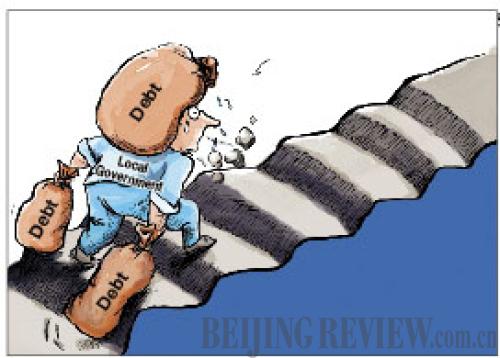|
Debt origins
 Why have local governments accumulated so much debt? Xie believes it was related to the country's finance and taxation system. Why have local governments accumulated so much debt? Xie believes it was related to the country's finance and taxation system.
For a long time, local governments acted as the primary driver of local economic development, Xie said. While strong economic intervention on the part of the government produced positive effects in terms of fueling economic development, these efforts required huge amounts of money to maintain the development drive.
In 1994, the Central Government reformed the finance system, which said the majority of local revenues should be handed over to the Central Government, leaving little money for local governments to spend. Consequently, raising money to support daily operation became, and still is, a local priority.
Since local governments cannot borrow money directly from the banks, the flexible local financing platforms open a new window for fund raising. It is easy for those platforms to obtain bank loans as they are backed by local government assets, like revenue, land and government credit.
After the outbreak of the global financial crisis, the Central Government proposed a 4-trillion-yuan ($587 billion) stimulus package to prevent a full-scale economic downturn.
But the Central Government was only responsible for raising 1.18 trillion yuan ($173 billion). The rest fell on the shoulders of local governments.
In 2009, the local financing platforms' craving for capital and the lending impulse of banks were a perfect match. Xie estimated about 80 percent of money raised by the platforms came from banks.
Extreme investment
On March 22, Hubei Province announced plans to invest 12.06 trillion yuan ($1.77 trillion)—three times the amount of the 2008 Central Government stimulus package and the largest local government investment plan to date—in local projects in the next few years. The amount is also 10 times Hubei's GDP in 2009.
On April 5, the Chongqing Development and Reform Commission announced an investment plan worth 1 trillion yuan ($147 billion), involving 33 key projects over the next five years. It planned to invest 200 billion yuan ($29.4 billion) by the end of 2010. Similarly, Yunnan Province announced a 3-trillion-yuan ($439 billion) investment plan, while Guangdong Province followed suit with a 2.3-trillion-yuan ($337 billion) proposal.
The bold investment plans all exceeded the local governments' capacity. A large proportion of funds will have to be raised through loans.
The CICC report estimated the outstanding loans of local investment platforms would reach 10 trillion yuan ($1.46 trillion) by the end of 2011—a figure the equivalent of one-third of China's GDP in 2009, or 70 percent of the country's foreign exchange reserves.
Searching for a solution
During this year's NPC (National People's Congress) and CPPCC (Chinese People's Political Consultative Conference) sessions, Minister of Finance Xie Xuren admitted problems in the financing platforms. But he said the Central Government would strengthen supervision over those platforms and set up risk-alert mechanisms to avoid problems.
When the mechanism will be adopted has yet to be determined.
Despite the immediate difficulties, Chinese officials and scholars were reluctant to restrict the borrowing inertia of the local financing platforms. Xie Wei said such platforms were the most active and effective financing bodies when coping with the economic downturn in 2009, and their future use should not be denied due to their potential risks. Xie said it was necessary that local governments utilize those platforms.
Liu Jipeng, an economics professor at the Capital University of Economics and Business, agreed. Since a large proportion of local revenue must be handed over to the Central Government, the local governments have been constantly faced with the problem of inadequate capital to support infrastructure construction projects. Liu said it is only natural then that they choose those financing platforms to achieve progress in the post-financial crisis world. | 